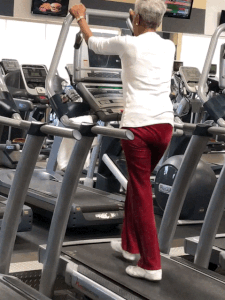
If you have Parkinson’s disease, you’ll be interested in a study that looked at low intensity and high intensity exercise for people with this condition.
The team at the University of Maryland School of Medicine and the Baltimore VA Medical Center had Parkinson’s patients use a treadmill for walking, and also had them do resistance exercise and stretching.
The low intensity group walked on a treadmill for 50 minutes. The “high” intensity group of Parkinson’s patients walked faster on a treadmill, with an incline, for 30 minutes.
The third group did the resistance exercise: leg presses, hamstring curls and leg extensions. The 67 subjects exercised three times a week over a three-month period.
All three groups experienced benefits, but the low-intensity group showed the most “consistent” improvement in mobility and gait.
This is the part that I question, because by far most people who don’t have mobility problems will incorrectly use a treadmill at an incline.
This incorrect use blocks progress. Since able-bodied people incorrectly use the incline on a treadmill, I have to assume that the subjects with Parkinson’s, as well, used the incline wrong in this study.
How does one use an incline wrong on a treadmill?
The user holds onto the bar across the front, or onto the rails on either side of his body, instead of swinging his arms naturally, as he would off the treadmill and on a real hill somewhere.
Though this sounds like the logical thing for a Parkinson’s patient to do, the apparent logic behind this does not eliminate the fact that holding on will block progress.
If a person holds on during incline walking, this prevents the movement from being “high” intensity…even if the person has Parkinson’s.
That’s because the faster the speed or the higher the incline, the harder the user will grip whicever part of the machine he or she is holding on!
Try it: Put the incline up as high as possible and speed at 4 mph, then walk this while holding on. It’s pretty easy if you’re gripping firmly enough.

This is why frail elderly or obese people, who are holding on, can be seen sustaining a medium walk at a high incline without showing signs of fatigue.
Parkinson’s causes difficulty with gait and walking. But despite these problems, even a Parkinson’s patient will get substantial external assistance if he holds on during an incline.
But if they let go, they’ll fall off, right? Not necessarily. Every patient is different (and some need walkers, in which case, they’d have to hold on).
But in other Parkinson’s patients, slowing down the speed may be all the patient needs to prevent from falling off if he keeps his hands off the rails or bars.
I do not know if the supervised exercise sessions for the UMSM study mandated a hands free experiment.
I’ve had a few Parkinson’s clients as a personal trainer and I had them keep their hands off the front bar and side rails, even if it meant sacrificing speed.
People need to get past the nutty idea that they shouldn’t sacrifice speed.
The bottom line is that I question the accuracy of the low intensity vs. “high” intensity walking in this study, if any of the patients were holding on; this would taint study results.









































